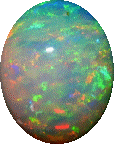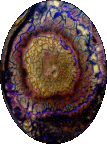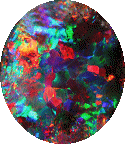| |
Opal
|
Opal comes from the Latin opallios, meaning “precious stone”. It is a solidified gel of silicon dioxide and water. Some of the folklore regarding the stone is due to a conflation of opallios with opthalmios meaning “eye stone”.
It is from this this mistranslation that the opal gains some of its folkloric attributes. Such etymology was cited when early writers claimed that the stone would sooth eye strain or cure diseases of the eye. Through this conflation the opal was also bestowed with the ability to make wearer invisible, and cause his actions go unnoticed. This trait led to the stone being stone to be known as the "Patron of Thieves". This is interesting because the stone itself has always been quite expensive, and so the probability that a burglar would be in possession of the stone is not very good.
The opal has a long history of being unlucky. It was credited with Queen Victoria’s wardrobe failure at her coronation, and the deaths of the Spanish royal family. Southern folklore in the United States holds that the stone is not only bad luck but attracts ghosts and evil spirits who create the misfortune. Other regions have myths of the opal binding with the life of the wearer in such a way that the stone’s hues and brightness become tied to the emotions of the wearer. Such a bond is so complete that the opal will fade with the owner's life as they die.
|
|
Pliny’s Opalus<'i>
|
The only positive attributes stem from Pliny’s accounts. While Pliny's opalus does at first seem to describe our opal with its many radiant colors, there are some issues with his physical description of the stone that calls into question if he is actually referring to the modern opal or another material entirely. Pliny wrote that the opalus was easily imitated. However, the modern opal is one of the most difficult to mimic and the process was only discovered in the last century or so. Where Pliny states that the opalus is hard and durable, our modern opal is one of the most delicate gems known, and quite soft. It will seemly crack at random due to changes in humidity or temperature, and you have to store opals separately so that they will not be damaged by other jewelry.
It is very possible that Pliny’s opalus was actually the edge of an iris agate that was properly cut in cabochon. This would match both the colors he was describing, as well as the hardness and durability. This leaves only the confusing detail regarding Pliny’s concern of fakes, to this I confess to being baffled.
|
Colors
|
White to black background with multihued iridescence
|
Locations
|
Australia, Brazil, Mexico, Czechoslovakia, Japan, Honduras, and the USA.
|
Compisition
|
SiO2 - nH2O, hydrated silicon dioxide
|
Hardness
|
4 - 4.5
|
|

|

|

|
|
|
|
|
|